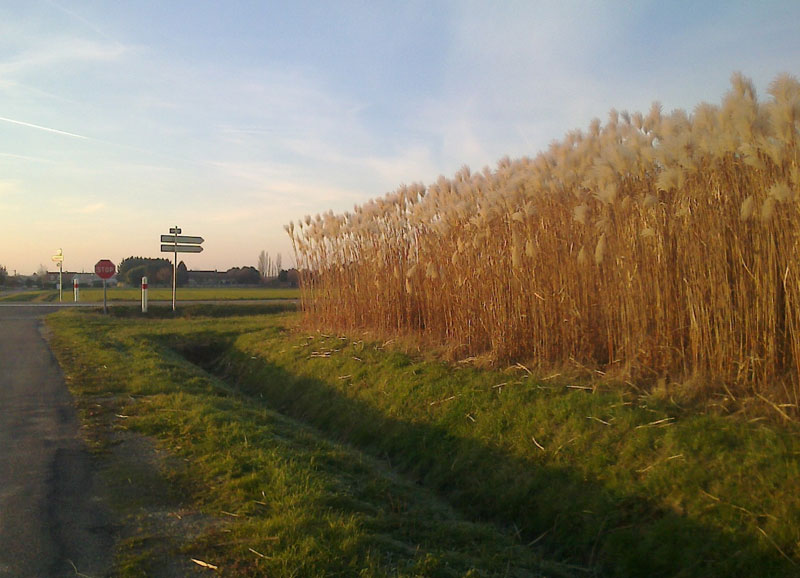by Florence Le Ber (Université de Strasbourg, ENGEES), Jean Lieber (Université de Lorraine, Inria) and Marc Benoît (INRA)
A farmer’s decision to plant new perennial biomass crops is a complex process that involves numerous parameters and can change the food / non-food balance. The paradigm of case-based reasoning is able to deal with the kind of complex and sparse information that is available in this situation, to model and forecast the allocation of these crops.
Perennial biomass crops are new renewable energy resources that could play an important role in replacing fossil fuels. The expansion of these crops seems unavoidable, and will raise global issues such as competition for space between food and non-food crops. To forecast their introduction in farming systems and their spatial allocation is thus a main challenge. Whilst several land-use change models deal with biomass crop allocation, most of them simulate large-scale allocation processes, taking into account numerous biophysical variables but only a few true-to-life human variables. In contrast, we aimed to model farmers’ allocation decisions regarding new perennial biomass crops as a complex agricultural management system, coupling social, technical and environmental variables.

Figure 1: A Miscanthus field in Burgundy.
As this objective raises knowledge acquisition and knowledge integration methodological issues, we proposed to model biomass crop allocation relying on case-based reasoning (CBR), a problem-solving paradigm. CBR consists of solving new problems by reusing the solution of similar problems that have already been solved [1]. A case corresponds to a problem-solving episode usually represented by a problem-solution pair. Cases are recorded in a case base. A source case is an element of the case base. The CBR process consists of solving a new problem, the target problem, using the case base. A common way of doing this is to select a source case similar to the target problem (case retrieval) and to modify the retrieved case so that it provides a solution that hypothetically solves the target problem (case adaptation). After these inference steps, some learning steps are sometimes implemented.
This approach was tested on a case study located in Burgundy (East of France), where a new perennial biomass crop Miscanthus sp. has been established since 2010.
In our model [2], a case is defined as a specific experience of Miscanthus allocation (or non-allocation) in a farm field. The case base includes 82 farm fields that have been described by farmers in past interviews (2011-2012) as having Miscanthus allocation potential. The problem-solution pair is a farm field and its allocation potential for Miscanthus. Each case is represented with a vector of qualitative values, divided into two parts: the problem part is a set of attributes, giving the farm field characteristics, as described by the farmer; the solution part describes the Miscanthus allocation potential of the farm field (0-no allocation, 1-allocation, or 2-possible allocation). The model also relies on a set of rules that formalise the elements given by farmers when explaining their decision to plant (or not plant) Miscanthus in a field.
To define a similarity measure between cases, we assumed that similar farm management and biophysical constraints of farmland enable analogue farmers’ decisions about crop allocation. The comparison of the source cases and the target problem is thus based on a comparison of their attribute values in terms of cropping plan, farm biophysical features and spatial farmland features.
In the adaptation step, we use the rules of the farmer associated to the source case to build the solution. Adaptation knowledge allows the appropriate rule to be chosen and applied, according to a given adaptation context: the system promotes the rules with conclusion 0 (when the context is not favourable for Miscanthus, e.g., because its price is low compared with traditional crops) or those with conclusion 1 or 2, if the economic context is favourable for Miscanthus.
Experiments showed the central role of the user, who has to choose parameters and adaptation contexts, and to examine results step by step: retrieved cases, available rules, proposed solutions. Rules in particular can be analysed to highlight the field characteristics that are important with respect to the farmer’s decision. Future work will deepen the use of rules for adaptation and explanation. This model could also be tested on other innovative crops. Finally, a formal model for the adaptation of crop allocation has been developed that is based on the application of belief revision in the qualitative algebra RCC8 setting (Dufour et al., 2012 ): this model still needs to be applied and validated on real farm data.
Farm surveys and knowledge modelling were funded by FUTUROL project [L1] and the French government.
Link:
[L1] https://www.projetfuturol.com
References:
[1] C.K. Riesbeck, R.C. Schank: 3Inside Case-Based reasoning”, Lawrence Erlbaum Associates Publishers, 1989.
[2] F. Le Ber, et al.: “A Reasoning Model Based on Perennial Crop Allocation Cases and Rules”, ICCBR. Springer, LNAI 10339, 61-75, 2017.
[3] V. Dufour-Lussier, et al.: “Adapting Spatial and Temporal Cases”, ICCBR. Springer, LNAI 7466, 77-91, 2012.
Please contact:
Florence Le Ber, ICube, Université de Strasbourg, CNRS, ENGEES, France
+33 3 88 24 82 30
Marc Benoît, ASTER, INRA, France
+33 3 29 38 55 01











